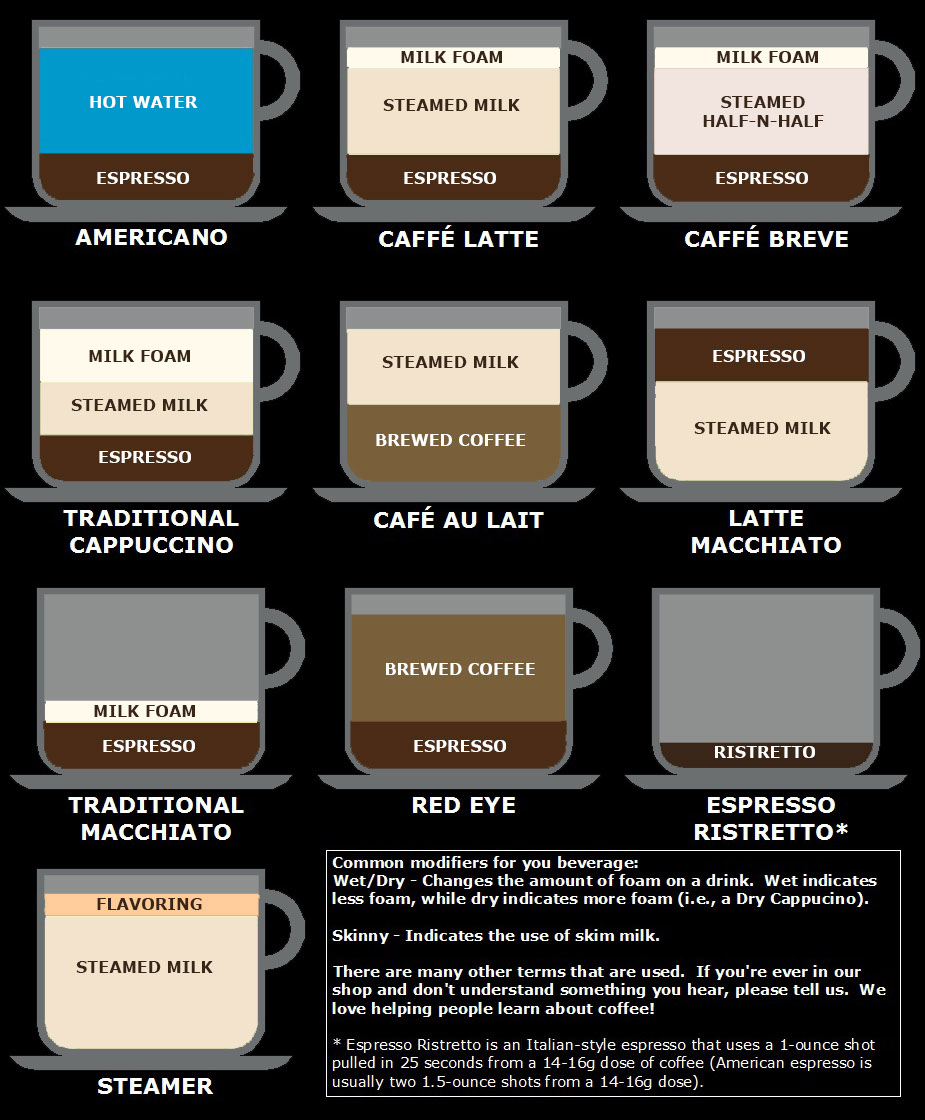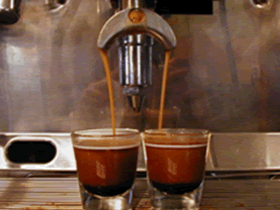Espresso Options
Common beverages made with espresso...
Often, the drink names and terms used in a coffeehouse can be confusing. However, this is not our intention. Nearly all the drink names used in a coffeehouse are Italian. Below are some of the more common hot drink options:

 What is espresso?
What is espresso?
Espresso is simply coffee. It is the end result of a very specific brewing process. Most of us are familiar with drip coffee, the black stuff that’s been served in the United States for hundreds of years. Drip coffee is created by allowing gravity to pull hot water through ground coffee. Espresso simply replaces gravity with a high pressure pump. Hot water (between 200 and 204°F) is forced through a set amount of very finely ground coffee at nine atmospheres of pressure. The result is very different from drip coffee.
Drip coffee relies on two main components for its flavor: acids and carbonized (or burnt) sugars. Espresso has three major flavor components: acids, carbonized sugars, and whole sugars. These whole sugars (combined with volatile aromatics and oils) are what gives espresso its unique and intense flavor. However, it requires a skilled barista to extract these sugars from the coffee.
The whole sugars and volatile aromatics found in coffee are very fragile. During the drip brewing process, nearly all of these sugars and aromatics are destroyed. Making (or pulling) espresso is the only way to preserve these sugars and aromatics. A proper American single espresso shot should be 1.5 oz, and should take between 23 and 28 seconds to pull (an Italian espresso shot will be much smaller). However, a good shot of espresso is not the end-all of a great espresso-based drink.
Once a good shot of espresso is pulled, it must be used quickly. The whole sugars in brewed espresso are still very fragile. These sugars begin to break down as soon as the temperature of the espresso drops by just a few degrees. This means that the sugars begin to break down after the shot has sat for only 15 seconds, and the sugars are nearly gone after the shot has sat for one minute. In addition, the volatile aromatics are contained within the bubbles of the crema, the very fine red-brown foam on top of the espresso. As the foam dissipates, the aromatics fall into the black coffee, and are destroyed by the acidity of the coffee.
One way to preserve the sugars in espresso is to add milk. The fat in the milk helps to preserve the sugars. Therefore, a proper latte or cappuccino should be made with whole milk, which contains a good amount of fat. Drinks can be made with skim, though they tend to be a bit more bitter. In addition, the alkalinity of the milk helps neutralize the acidity of the coffee, allowing the aromatics to stick round.
Another component that sets espresso apart from drip coffee is its mouthfeel, or body. Drip coffee is filtered using a paper filter that traps most of the fats (or oils) in the coffee. Because these fats are removed, coffee has a consistency similar to that of water or juice. Some oils do make it into the coffee, giving some coffees (such as Sumatra) a fuller body. However the body of drip coffee is nothing compared to espresso.
Espresso is filtered using a metal filter (called a basket) that fits into the portafilter (the device that locks into the espresso machine). This metal filter allows the fats in coffee to flow through into the final product. This gives espresso a very rich mouthfeel, much more similar to milk or cream. In addition, air is added to the liquid while the shot is pulled. In fact, a good shot should exit the machine as entirely foam. This also adds to the richness, or creaminess of the shot.
It is important to realize that poorly pulled espresso will not contain whole sugars or much body, essentially no better than strongly brewed drip coffee. Espresso should never be bitter, and should never be watery.
Tell me about your espresso blend…
At the River Road Coffeehouse, we use our own locally roasted espresso blend from one line coffee. This espresso is a blend of three different origin coffees that is typical for espresso and each coffee is roasted to a different level before creating the blend. Most coffeehouses (including most chains) use a darker roast for their espresso. However, we find this to be a sin against espresso. The reason espresso is made (among others) is to create a beverage that contains the whole sugars found in coffee. Using a dark-roasted espresso (in which most of the sugars have been burned during the roasting process) doesn’t make sense. It is easier to pull a proper shot with a dark-roasted espresso, but this shot will not be nearly as rewarding as a proper shot pulled with a lighter roast.
We could use an even lighter roast than we currently use for our espresso, but it wouldn’t be wise. Many of our customers buy espresso-based drinks that include chocolates and syrups. When used in a drink, these syrups are balanced by the carbonized sugars (or burnt sugars) in the coffee. If we were to use a lighter roasted espresso, there would not be enough carbonized sugars to balance the syrups, allowing the syrups to overpower the espresso.
Our espresso blend is called Method Blend and was created by our head roaster, David Forman. He has also created a decaf Technique Blend espresso featuring three Fair Trade origin coffees that are decaffeinated using a “Mountain Water Process”.
As important as the quality of our espresso blend is, it is the baristas of River Road Coffeehouse that make our coffee special. What most coffee drinkers do not know is that 90% of how a drink tastes depends on the barista. Here at River Road, our baristas are trained for many hours before they are allowed to make drinks for our customers. This ensures that our customers are served only the finest espresso-based drinks.

